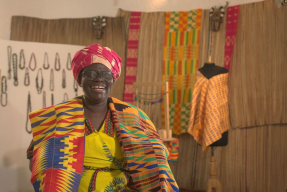I told myself I’d avoid writing a blog entry that involved too much rumination on the meaning of microfinance. Oops.
Before I left for Paraguay, I had a long conversation with Cara Gutterman, the first Kiva Fellow assigned to Fundación Paraguaya. In addition to giving me some insight into the food (fine) and the weather (very, very hot), Cara told me that many of the borrowers she met during her time in Paraguay didn’t seem to be lifting themselves out of poverty; in fact, they didn’t seem to be the poorest of the poor, but instead were a group of hard-working, above-the-poverty-line folks who used credit simply to maintain their level of income. (Cara wrote a great blog entry on this issue and what it suggests about the relationship between microfinance and poverty).
Now that I too have met some borrowers who fit this description, I spend a lot of time thinking about what they mean to the Kiva lender and to the Kiva brand—those familiar green leaves that stand for empowering the impoverished. (I’m definitely not the only Kiva Fellow to have tackled this or similar issues, as can be seen in an earlier post: Discussion on Microfinance). Questions abound: How would Kiva lenders feel if they got the impression that their money wasn’t going to someone who is impoverished, but instead to someone who might be considered a member of Paraguay’s lower-middle or working class? Are such loans misrepresentations of the Kiva brand? If so, where’s the feel-good line? At what point do we stop feeling good about the income level of the borrowers we support and start feeling worried that our money isn’t doing what we want it to do?
Kiva has facilitated more than $2 million of investment in the people of Paraguay, and each week that I spend meeting the beneficiaries of this investment, my feel-good line moves up a notch or two. Many of the borrowers that Fundacion Paraguaya reaches, especially the participants in FP’s Women’s Entreprenuership program, are extremely poor; and I’m still moved and energized when I meet a low-income borrower who, by combining capital with entrepreneurial instinct, starts making enough money to send all of her children to school. But I’m equally pleased when I meet someone like Jorge Romero, whose 18-year-old barber shop provides a solid, steady income for him and his family. Kiva money didn’t lift Mr. Romero out of poverty. Instead it strengthened an already stable business, supported a popular, visible storefront in the small town of Ita, and probably gave Mr. Romero, his partner, and his daughter the financial resources they needed to live just a little bit more comfortably. These aren’t the type of results that caught Oprah’s eye or made Kiva “The only non-profit that matters”, but they are the results that healthy communities are built on.

Jorge Romero at work in his barber shop
That’s because a loan to Jorge Romero isn’t just a loan to Jorge Romero. In any given month, he might catch a ride in Benedicto Gonzalez’ taxi, ask Juan Carlos Cardozo to build his daughter a new bed, or purchase tobacco sold by Maria Ines Bordon. These connections stir the economy and, more importantly, create opportunities for other Fundacion Paraguaya entrepreneurs to enter the market and start the climb towards financial stability. Were we as a lending community to reject borrowers like Mr. Romero because we didn’t think they were “poor enough,” we would mitigate Kiva’s ability to bring about larger scale, sustainable change in the communities where we invest our money.
So I think the brand is safe. Yes, the green leaves stand for the fight against poverty, but they also stand for growth, and if leaves are to stay vibrant and strong, they need an environment that nourishes the saplings along with the sprouts.
And where is the feel-good line? Let me put it this way, if one day Kiva changed its mission statement to read: Kiva’s mission is to connect people through lending for the sake of alleviating poverty and strengthening the middle class across the globe, I’d feel great about it, and I’d argue that you should too.
******************************
Want to hear more from Paraguay? Join the rapidly-growing Team Fundación Paraguaya!
/>PREVIOUS ARTICLE
Protecting Microfinance Clients: Principle 6 →NEXT ARTICLE
Welcome, Kiva, to West Timor! →













